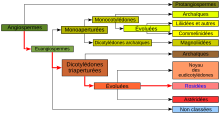Anisophylleaceae
La famille des Anisophylléacées (Anisophylleaceae Ridl.) est constituée de plantes dicotylédones ; elle comprend 36 espèces réparties en 4 genres.
| Règne | Plantae |
|---|---|
| Sous-règne | Tracheobionta |
| Division | Magnoliophyta |
| Classe | Magnoliopsida |
| Sous-classe | Rosidae |
| Ordre | Rosales |
| Clade | Angiospermes |
|---|---|
| Clade | Dicotylédones vraies |
| Clade | Rosidées |
| Clade | Fabidées |
| Ordre | Cucurbitales |
| Famille | Anisophylleaceae |
- Polygonanthaceae Croizat[1]
Ce sont des arbres et des arbustes des zones humides originaires des régions tropicales (forêts pluviales primaires).
Étymologie
modifierLe nom vient du genre type Anisophyllea dérivé du grec άνισος / anisos, inégal, et φύλλων / fyllon, feuille, en référence au dimorphisme[note 1] des feuilles[2].
Classification
modifierCette famille a été décrite en 1922 par le botaniste britannique Henry Nicholas Ridley (1855-1956)[3].
La classification phylogénétique APG IV (2016)[4] situe cette famille dans l'ordre des Cucurbitales, comme c'était déjà le cas en classification phylogénétique APG (1998)[5], classification phylogénétique APG II (2003)[6] et classification phylogénétique APG III (2009)[7].
En classification classique de Cronquist (1981)[8], elle est assignée à l'ordre des Rosales.
Liste des genres
modifierSelon Angiosperm Phylogeny Website (26 mai 2010)[9], NCBI (26 mai 2010)[10] et DELTA Angio (26 mai 2010)[11] :
- genre Anisophyllea R.Br. ex Sabine
- genre Combretocarpus Hook.f.
- genre Poga Pierre
- genre Polygonanthus Ducke
La phylogénétique moléculaire moderne suggère les relations suivantes[12],[13] :
| |||||||||||||||||||||||||
Notes et références
modifierNotes
modifier- Diversité de la forme d'un même organe ou de plusieurs organes sur un même individu ou sur des individus différents de la même espèce.
Références
modifier- USDA, Agricultural Research Service, National Plant Germplasm System. Germplasm Resources Information Network (GRIN-Taxonomy). National Germplasm Resources Laboratory, Beltsville, Maryland., consulté le 25 février 2019
- Cosmovisions-Dimorphisme
- (en) The Flora of the Malay Peninsula 1: 700. 1922.
- (en) Angiosperm Phylogeny Group, « An update of the Angiosperm Phylogeny Group classification for the orders and families of flowering plants: APG IV », Botanical Journal of the Linnean Society, Wiley-Blackwell, Linnean Society of London et OUP, vol. 181, no 1, , p. 1-20 (ISSN 0024-4074 et 1095-8339, DOI 10.1111/BOJ.12385).
- (en) Angiosperm Phylogeny Group, « An ordinal classification for the families of flowering plants », Annals of the Missouri Botanical Garden, Jardin botanique du Missouri, vol. 85, no 4, , p. 531–553 (ISSN 0026-6493, 2162-4372, 0893-3243 et 2326-487X, DOI 10.2307/2992015, JSTOR 2992015, lire en ligne).
- (en) Angiosperm Phylogeny Group, « An update of the Angiosperm Phylogeny Group classification for the orders and families of flowering plants: APG II », Botanical Journal of the Linnean Society, Wiley-Blackwell, Linnean Society of London et OUP, vol. 141, no 4, , p. 399–436 (ISSN 0024-4074 et 1095-8339, DOI 10.1046/J.1095-8339.2003.T01-1-00158.X).
- (en) Angiosperm Phylogeny Group, « An update of the Angiosperm Phylogeny Group classification for the orders and families of flowering plants: APG III », Botanical Journal of the Linnean Society, Wiley-Blackwell, Linnean Society of London et OUP, vol. 161, no 2, , p. 105–121 (ISSN 0024-4074 et 1095-8339, DOI 10.1111/J.1095-8339.2009.00996.X).
- (en) Arthur Cronquist, An Integrated System of Classification of Flowering Plants, New York, CUP, (ISBN 0-231-03880-1, OCLC 1136076363, lire en ligne).
- Stevens, P. F. (2001 onwards). Angiosperm Phylogeny Website. Version 14, July 2017 [and more or less continuously updated since]." will do. http://www.mobot.org/MOBOT/research/APweb/, consulté le 26 mai 2010
- NCBI, consulté le 26 mai 2010
- DELTA Angio, consulté le 26 mai 2010
- Schwarzbach AE, Ricklefs RE, « Systematic affinities of Rhizophoraceae and Anisophylleaceae, and intergeneric relationships within Rhizophoraceae, based on chloroplast DNA, nuclear ribosomal DNA, and morphology », Am J Bot, vol. 87, no 4, , p. 547–564 (DOI 10.2307/2656599 , JSTOR 2656599)
- ((Zhang L-B)), Simmons MP, Renner SS, « A phylogeny of Anisophylleaceae based on six nuclear and plastid loci: Ancient disjunctions and recent dispersal between South America, Africa, and Asia », Molecular Phylogenetics and Evolution, vol. 44, no 3, , p. 1057–1067 (PMID 17433719, DOI 10.1016/j.ympev.2007.03.002, lire en ligne)
Liens externes
modifier- (en) Référence BioLib : Anisophylleaceae (Schimp.) Ridl. (consulté le )
- (en) Référence Catalogue of Life : Anisophylleaceae Ridl. (consulté le )
- (en) Référence DELTA Angio : Anisophylleaceae (consulté le )
- (en) Référence GRIN : famille Anisophylleaceae (+liste des genres contenant des synonymes) (consulté le )
- (fr + en) Référence ITIS : Anisophylleaceae (consulté le )
- (en) Référence Jardin botanique du Missouri : Anisophylleaceae (images de Madagascar) (consulté le )
- (en) Référence NCBI : Anisophylleaceae Ridl., 1922 (taxons inclus) (consulté le )
- (en) Référence Tree of Life Web Project : Anisophylleaceae (consulté le )
- (en) Référence Tropicos : Anisophylleaceae Ridl. (+ liste sous-taxons) (consulté le )

